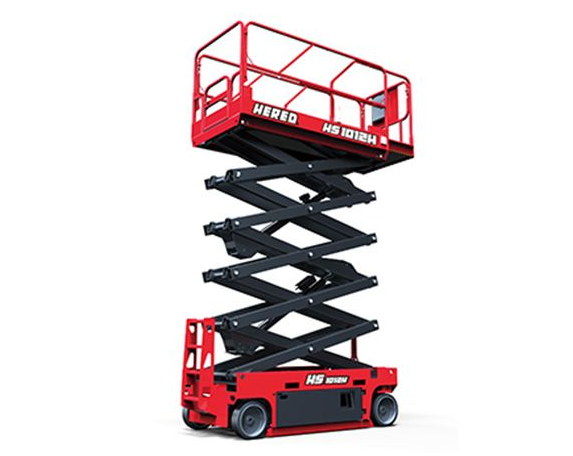Scissor Lifts for Building Maintenance: A Solution for Height Access and Safety
In large-scale projects, a variety of equipment and machinery come into play. This article will specifically delve into the advantages of utilizing scissor lifts for building maintenance, highlighting why these machines can serve as an ideal solution for your project requirements.
What is a Scissor Lift?
Scissor lifts are commonly employed for lifting workers or heavy loads to elevated positions. While various types of these machines exist, it is essential to first understand what a scissor lift is before delving into specific advantages and types.
A scissor lift falls under the category of Elevated Work Platforms (EWPs) designed to securely transport workers and heavy loads across different elevated levels. In construction projects, these machines offer a safer alternative to ladders and scaffolding due to their enhanced stability and excellent mobility.
Here are a few main components of scissor lifts to better understand how they work:
1. The Lift Platform serves as the surface for carrying workers and their tools, typically featuring a safety guardrail around its perimeter to ensure the security of both personnel and equipment.
2. The Scissor Legs refer to the crisscross metal structure connecting the base to the platform. The size of each leg dictates the overall working height of the lift.
3. The Lift Cylinders are responsible for expanding or compressing the scissor legs. These cylinders may utilize compressed air or hydraulic fluid, with changes in pressure determining whether the platform ascends or descends.
4. The Lift Base is a metal frame equipped with sturdy brackets, ensuring the machine's overall stability.
5. The Lift Power Source, as implied by its name, provides power to the lift. Various power sources, such as remote power packs or self-contained motors, are used based on the lift type.
6. The Down Valve, connected to the power supply, regulates the platform's descent speed by returning hydraulic fluid or compressed air to its container.
7. The Flow Control Valve determines the rate at which compressed air or hydraulic fluid returns or leaves the reservoir, influencing the platform's upward or downward movement.
While the components of scissor lifts remain largely consistent across different types, the primary distinction lies in their cylinder mechanisms.
Features of Scissor Lifts
1. Scissor lifts come with a multitude of features, and these can vary based on the model and manufacturer. Nevertheless, there are some common characteristics present in each type.
2. The platform size indicates the available workspace and the number of individuals who can simultaneously work on the lift.
3. The working height specifies the maximum elevation the lift can achieve when fully extended, typically ranging from 6 to 18 meters, depending on the model.
4. The weight capacity denotes the maximum load the lift can support, varying from 500 to 3,000 pounds.
5. Scissor lifts utilize two main power sources: electric and hydraulic systems. Electric lifts, known for their quieter and more efficient operation, are well-suited for indoor use. In contrast, hydraulic lifts provide more power and are preferable for outdoor tasks.
Specific features may differ across models and manufacturers, allowing you to choose the one that best aligns with the requirements of your projects.
Types of Scissor Lifts for Building Maintenance
Now that you know the basic information about scissor lifts, there are actually several types to choose from. The differences between each type of scissor lift are specific to certain tasks.
So, what are these types?
Electric Scissor Lifts
Primarily utilized for building maintenance and indoor tasks, electric scissor lifts are powered by rechargeable batteries. They are environmentally friendly, emitting no fumes and generating minimal noise. Additionally, these lifts are cost-effective, requiring less maintenance compared to other variants.
Rough Terrain Scissor Lifts
Specifically engineered for uneven surfaces such as construction sites, rough terrain scissor lifts feature heavy-duty wheels and a robust suspension system, enabling them to navigate challenging outdoor environments. These lifts are an optimal choice for building maintenance projects in harsh conditions.
Diesel Scissor Lifts
Powered by diesel engines, diesel scissor lifts are designed for outdoor use, providing enhanced power compared to electric variants. They are well-suited for demanding outdoor building maintenance tasks.
Hybrid Scissor Lifts
Combining the advantages of electric and diesel scissor lifts, hybrid scissor lifts operate on a blend of electric batteries and diesel engines. This hybrid design offers a more environmentally friendly and cost-effective solution, allowing for versatile use both indoors and outdoors.
Trailer Mounted Scissor Lifts
Designed for easy transport and setup, trailer-mounted scissor lifts can be attached to trailers and towed to different locations by a vehicle. These lifts are efficient for building maintenance projects that require mobility across various sites.
Self-Propelled Scissor Lifts
Engineered for maneuverability, self-propelled scissor lifts feature wheels and a steering system that enables workers to move the machine independently, eliminating the need for external assistance.
Choosing the right type of scissor lift depends on your specific project needs, considering the diverse challenges and demands in construction and maintenance projects. Top-performing scissor lift brands include Genie and Sinoboom, offering options such as battery-driven and engine-driven lifts.
The Advantages of Scissor Lifts in Building Maintenance
Elevated work platforms, such as scissor lifts, offer numerous advantages for building maintenance tasks. Here are several reasons why incorporating scissor lifts can be beneficial:
1. Productivity:
The efficiency of scissor lifts facilitates loading activities, providing workers with a streamlined process. Their mobility ensures a quicker turnaround for tasks that may be more challenging when using ladders or scaffolding.
2. Safety:
Working at considerable heights with heavy loads poses potential risks, especially when dealing with cumbersome tools. Scissor lifts ensure a safe and smooth ride on their platforms, featuring a larger working area with surrounding railings. Additional safety measures, such as provisions for harnesses, help prevent accidents and falls.
3. Ease of Use:
Despite being heavy machinery, scissor lifts are surprisingly easy to operate. This quality reduces operator fatigue, and even new operators can grasp the system within a few days.
4. Compact Design:
Scissor lifts are relatively smaller compared to other elevated work platforms. The size of the machine corresponds to the liftable platform, making compact scissor lifts easy to store and maneuver in confined spaces or tightly packed warehouses.
5. Versatility:
Scissor lifts serve a wide range of building maintenance tasks, including painting, window cleaning, light bulb replacement, roof and facade repairs, and electrical wiring fixes. Their versatility helps reduce costs and risks associated with other equipment, making various jobs more manageable.
Incorporating scissor lifts into building maintenance operations not only enhances efficiency but also contributes to a safer and more adaptable working environment.






